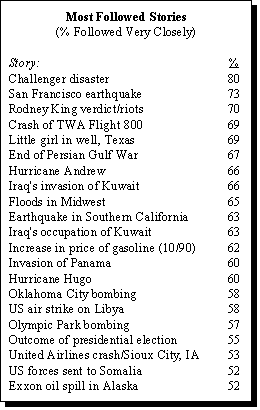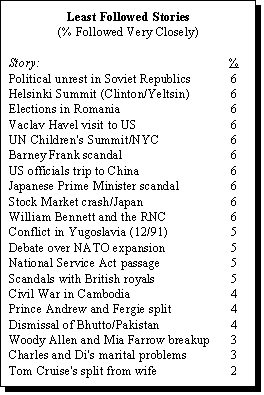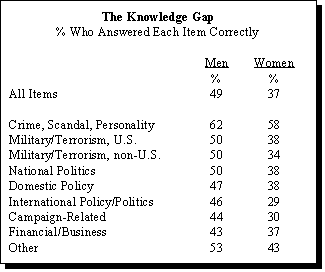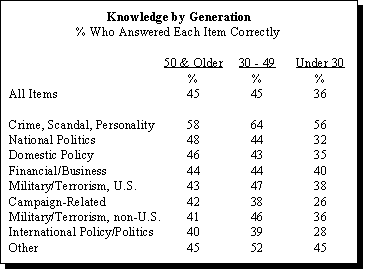Survey Findings
An analysis of public attentiveness to more than 500 news stories over the last ten years confirms that the American public pays relatively little attention to many of the serious news stories of the day. The major exceptions to this rule are stories dealing with natural and man-made disasters and U.S. military actions.
The news interest database is built from an ongoing series of questions which asks people how closely they have followed certain news stories during the previous month… “very closely, fairly closely, not too closely, or not at all closely?” The stories, 554 in all, represent a wide range of subjects from politics to sports to science and technology. They are compiled from 65 separate nationwide surveys including interviews of over 80,000 respondents.
A examination of nearly 200 information questions collected over the same ten year period provides some insight into the extent to which major news stories are understood and absorbed by the public. This analysis shows that there are significant gaps in knowledge between men and women and among people of different generations. Women and young people (those under 30) are less well-informed on basic facts about current events. These gaps are less evident in news interest, suggesting that interest and attentiveness do not necessary translate into knowledge.
The Appeal of Disaster

Overall, the public is not particularly engaged by the large majority of stories covered by the news media. On average, one fourth of the public followed the stories measured by the Center “very closely,” another 32% “fairly closely”, and fully 43% not closely at all. There are, however, exceptions to this general disinterest. Chief among these are stories about disasters, natural and man-made, and U.S. military interventions, which garner great attention.
The list of most closely followed stories of the past ten years is topped by the Challenger disaster, which was followed very closely by 80% of the American public. Second on the list: the San Francisco earthquake of 1989 , followed very closely by almost three-fourths of the population. The remaining stories in the top 25 are also primarily about man-made or natural disasters, along with several stories about wars and military actions. Three stories from 1996 made the top 25 list: the crash of TWA Flight 800, the Olympic Park bombing, and the 1996 Presidential election outcome (interestingly, the only political item in this group).1

The list of least closely followed stories provides a sharp contrast to the above. Featured prominently here are stories dealing with foreign governments and foreign politicians, such as the dismissal of Benazir Bhutto in Pakistan, the civil war in Cambodia, and political unrest in the Soviet Republics. Somewhat surprisingly, the lowest of the low are celebrity scandal stories. Again, there are three new additions to the list from 1996 and 1997: the Helsinki summit between President Clinton and Russian President Yeltsin; the debate over NATO expansion; and the marital problems of England’s Prince Charles and Princess Diana.
Grouping stories by subject matter provides a broader picture of the types of stories Americans choose to follow, confirming the insights gleaned from looking at the top and bottom stories alone. Overall, the most widely followed categories of news stories were natural and man made disasters (followed very closely by 45% and 44% respectively), next were stories about the U.S. military or terrorism involving the United States (41%). In comparison, business and economic stories are followed very closely by three-in-ten Americans, and campaigns and elections by only 23%. Stories involving people and places outside the U.S. have a much smaller audience than any of the above topics. Finally, few Americans say they pay close attention to stories about political or celebrity scandal, or to those focusing on entertainment. As we will soon point out, however, knowledge about this latter group of topics is relatively high.
Worth keeping in mind in an analysis of most followed stories is the fact that what Americans choose to follow is at least partially dictated by what the media chooses to cover. It is hard, in other words, to miss the coverage of a major earthquake. It is not so hard to miss news about Cambodia. However, there are instances where news stories which receive quite extensive and continuous coverage simply fail to attract public interest. An example of this is the civil war in Bosnia, which on average has been followed very closely by 15% of the public.
Men, Women, and the News

Men and women are equally likely to say that they followed the average news story very closely (26% of men and 24% of women), but there are some moderate differences in the type of news stories each tends to follow. Men are more likely to follow stories about: military action, be it American or foreign; international politics; business and finance; political scandal; and most of all, sports. Some of the stories which attracted significantly more men than women include: the U.S. Navy escorting Kuwaitis in the Persian Gulf in October 1987 (21% point gap), the U.S. air strike on Libya (20% point gap), and the 1990 NFL playoffs (19% point gap).
Women, on the other hand, are somewhat more likely to follow disaster stories and stories about court rulings (many of which concern abortion policy). Particular stories which showed a gender gap in attentiveness in favor of women included the court ruling on the fate of baby Jessica (21% more women than men paid very close attention), this year’s controversy over mammograms (19% point gap), and the 1989 Supreme Court ruling on abortion (14% point gap).
The large gender gap displayed in the most recent Presidential elections does not extend to news attentiveness in these areas; men are only 2% points more likely to follow stories about domestic policy and election campaigns, and 3% points more likely to follow stories about national politics in general.2
Older Americans More Tuned In

Americans over age 50 are much more attentive to a variety of types of news, particularly when compared with those under age 30. This comes across clearly in the attention paid to politics and policy. Those over 50 are almost twice as likely as members of Generation X to say they follow national politics and domestic policy very closely, and 10% points more likely to follow election campaigns and international politics. Almost one quarter of those over 50 say they follow stories about political scandal very closely, compared to only 11% of those under 30. Older Americans are also much more likely to follow stories about disasters, and about business or finance.
Correspondingly, Generation Xers trail behind their elders in news attentiveness on many subjects. The only category in which they lead both age groups is sports. In general, Americans in the 30 to 49 age group find themselves somewhere in the middle on news attentiveness, though their consumption patterns are more like younger Americans than those older than themselves. This generational pattern is likely affected by both time and interest, with senior citizens in particular the beneficiaries of larger amounts of free time for news consumption.
Knowledge of the News
In addition to tracking news interest, the Center has, over the past ten years, periodically tested the public’s knowledge of current events on a range subjects from entertainment news to sports to world events. On average 43% of the public has answered these information questions correctly. This is higher than the proportion that follows major news stories “very closely” (25%), suggesting that some information gets to those segments of the public that do not consider themselves highly attentive to the news. Information questions are a valuable tool for measuring the extent to which certain facts and occurrences penetrate the public psyche and become part of the base of knowledge from which Americans formulate their opinions.
The question that has drawn the highest percentage of correct answers since we began polling in 1987 is, “Can you tell me which president had to resign because of the so-called Watergate scandal?” In May of 1994, 91% of the public were able to identify Richard Nixon in that context.3 Other information questions that made it into the top five were knowledge that: the United States has a trade deficit rather than a surplus with Japan (83%), General Manual Noriega hid in the Vatican embassy during the 1990 U.S. invasion (82%), the federal government spends more money than it takes in (81%), and the reason Zsa Zsa Gabor was in the news in the fall of 1989 was because she was arrested in Beverly Hills (80%).
The information questions at the bottom end of the scale, that is those that were known by the smallest percentages of the public, cover an equally wide range of subjects. The one question we have asked over the past ten years which has drawn the lowest percentage of correct answers is, “Do you happen to know what proportion of privately owned U.S. real estate is owned by foreign investors?” In 1989, only 4% were correct in choosing less than 5% on this multiple choice question. Other little known facts included the meaning of the term “politically correct.” Seven percent answered this open-ended question correctly in 1991, in the midst of the public debate over affirmative action and multiculturalism. Less than one in ten (9%) knew that the “peace dividend” referred to the money we may save on defense spending because of the reduction in tensions between the U.S. and the Soviet Union. Equally small percentages were able to identify such news makers as Samuel Pierce, John Major, and Vaclav Havel (10% for each).
Of the nearly 200 questions in the knowledge database, 59 involve identifying specific people. After Richard Nixon, the individual most readily identifiable by the public was William Kennedy Smith. In May of 1991, 75% of the public could identify the famous Kennedy nephew in an open-ended question. Nearly as many (70%) were able to identify the slain child beauty queen JonBenet Ramsey earlier this year, as many as could name the current Vice President in 1994. Nearly two-thirds (65%) were able to identify Lance Ito as the judge in the O.J. Simpson case, and an equal number knew who Corazon Aquino was.
Public knowledge of current events varies significantly across different subject categories. While the news interest index suggests that the public pays little attention to news stories about celebrities and scandal, our knowledge data suggests that the public knows more about these types of stories than it does about virtually any other category of news. On average the public answered 60% of the questions dealing with scandal, entertainment and crime correctly.4 The items included in this category range from: ‘who is JonBenet Ramsey?’, to ‘why has televangelist Jim Bakker’s trial been delayed?’, to ‘which country recently built a new Disney amusement park?’
Well less than half of the public (43%) correctly answered questions dealing with the military and terrorism where the U.S. was directly involved. Similar proportions correctly answered questions about domestic policy, business and finance, national politics, and military and terrorism where the U.S. is not involved. The public is less well informed about international policy and campaign news. Fewer than four in ten correctly answered questions on these topics.
Gender, Generation and Knowledge of News Events

While the gender gap in news interest is not pronounced, the gap in knowledge is wide and far-reaching. On average men have answered nearly half (49%) of our information questions correctly. This compares with only 37% of women. The biggest gaps in knowledge can be seen on questions dealing with international policy and politics where on average 46% of men and 29% of women answered the questions correctly. The gap is equally large on questions dealing with military and terrorism where the U.S. is not directly involved (50% of men and 34% of women answered these questions correctly).
Significant gaps also exist on campaign-related questions (14% point gap), military and terrorism where the U.S. is involved (12% point gap), national politics (12% point gap), and domestic policy (9% point gap). The gap is smaller on questions dealing with business and finance. The only news category about which men and women are equally knowledgeable is crime, scandal and personality.
It is possible, of course, that other factors, such as socio-economic status, may be driving the differences between men and women. However, a separate analysis of Pew data suggests that education does little to mitigate the differences in levels of knowledge between women and men. College-educated men are significantly more knowledgeable than any other group. College-educated women are only slightly more informed that men without college degrees. Women without a college degree are the least knowledgeable, except with regard to entertainment news. In this case, non-college educated women are more knowledgeable than women with degrees.
This analysis also found that life situation factors have some influence on levels of knowledge for both women and men. Women who are employed full time are no more knowledgeable than women who are employed part time or not at all. However, educated women who work full time are more knowledgeable than educated women who do not work full time. The same holds true for men.5

Generation gaps in knowledge are as substantial and as persistent as gender gaps. The great divide seems to be between those over 30 and those under 30. On average 36% of those under 30 answered the information questions correctly, this compares with 45% of those age 30-49 and those 50 and over. The biggest generation gaps can be seen on questions dealing with campaigns and elections and national politics. Only 26% of young people answered our campaign-related questions correctly, this compares with 38% of those 30-49 and 42% over those 50 and over. On national politics, young people averaged 32% correct, compared to 44% of middle aged Americans, and 48% of those 50 and older.
Big gaps also exist on international politics and policy, domestic policy, and military and terrorism. The gaps are smaller on crime, scandal and personality issues. Young people are nearly as well informed as their older counterparts when it comes to business and finance.
A 1990 Times Mirror study entitled Age of Indifference analyzed these generational gaps in depth and reported that young people have not always lagged behind in terms of knowledge.6 Survey results from the 1940s through the 1970s revealed that previous generations of younger people knew as much as, if not more than, older members of the population.
In spite of the persistent generation gaps in the current data, there are some interesting examples of instances where Americans under 30 do know more than those over 30. One question where young people knew more than both middle aged and older Americans involved the minimum wage. In April of 1996, 49% of those under 30 know the current minimum wage was $4.25. This compares with 42% of those age 30 to 49 and only 38% of those 50 and older.
In several other cases young people displayed higher levels of knowledge than those 50 and older, but still trailed those in the middle age group. Some examples include questions about the Internet, Windows 95, the judge in the O.J. Simpson criminal trial, a 1989 Supreme Court ruling on abortion, the TV sitcom that Dan Quayle criticized during the 1992 campaign, and the spacecraft Voyager 2.
The under 30 group only out-smarted those 30 to 49 on a few information questions. The biggest such gap appeared in 1990 when 53% of young people knew that the Social Security system was currently taking in more money than it was paying out. Those over 50, many of them recipients of Social Security benefits, were equally well informed on this point (51%). However, only four in ten (41%) of 30 to 49 year olds were aware of this.
Concluding Thoughts
Both the knowledge and attentiveness series are an attempt to answer the question: how engaged are Americans with the important (and not so important) news stories of the day. Yet each measurement strategy provides slightly different results. We are left, then, trying to make sense of these patterns in order to make use of our data.
In a general sense, the two measurements do not map onto each other in any obvious way. For most categories of news, people are more likely to be able to answer a knowledge question than they are to pay very close attention to the stories.7 This, perhaps, is not surprising, since it is often possible to pick up the gist of a story without following it on a day to day basis.
A particularly conspicuous example of this is the difference between professed attention and knowledge of stories involving entertainment, scandal and crime. These stories fall at the bottom of the news attentiveness scale, but at the top of the knowledge scale. There are at least three possible explanations for this. First, the news attentiveness figures might be depressed by a social desirability effect, in which people are loathe to admit they are following less serious stories. Second, it is possible that these stories are conceptually less challenging, and so easier to grasp even without a major investment of attention. For example, it takes some work to understand the situation in Bosnia, while the plotline of the Michael Kennedy story is fairly straightforward. Finally, this result could be driven by intense coverage of entertainment and scandal stories, so that even if one is not paying close attention, it is hard to miss the point.
Another interesting difference between the two measures is the fact that the gender gap is relatively small and erratic in news attentiveness, but large and consistent in the knowledge questions. We know from previous research that this latter difference is not about education or work status individually. Perhaps the discrepancy could be attributed to a difference in socialization, where men continue to be socialized to treat news information as important in terms of memory retention whereas women dismiss the information more easily. On a more prosaic note, it is also possible that the the knowledge questions are the more valid measure, since it is difficult to exaggerate on these questions, but altogether possible to do so on the news attentiveness questions. An alternative methodological explanation is that by only looking at differences in the response category “very closely” in news attentiveness we are missing larger gender differences in the bottom categories. Whatever the explanation, this difference seems worth exploring.




